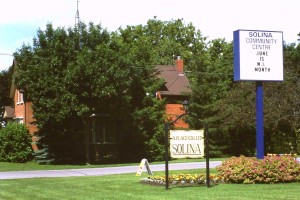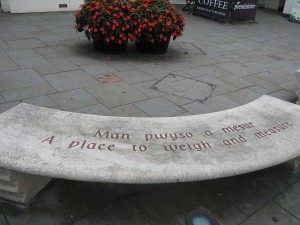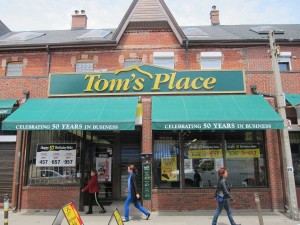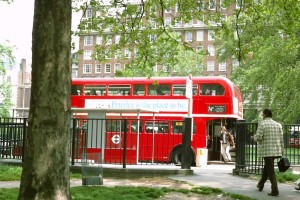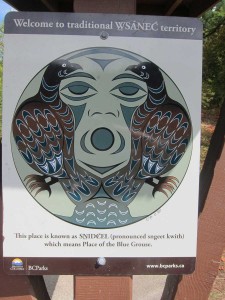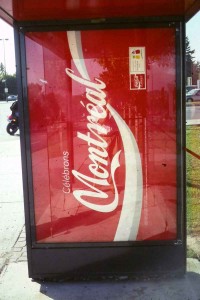There’s another topo- word, toponymy, which means the study of place names, their origins and history. It’s an arcane field that has been given almost no attention by those geographers (including me), psychologists, architects and philosophers who have written about place and spirit of place. This is a bit surprising because place attachment, roots, dwelling, attachment, openess, thrown-togetherness, boundaries and sense of place all involve particular places with their own names, and none of those theoretical discussions have much substance except in the context of experiences of particular places.
Deroy and Mulon suggest in the preface to their 1992 Dictionnaire de Noms de Lieux that the proper names of places are like money (dollar bills and euros and so) because they are used with no more attention to them than their everyday utility. They serve as a sort of geographical shorthand that helps us find our way around the world and is indispensable to communication because they obviate the need for cumbersome descriptions (such as “the cupboard under the stairs” – a description that by its very lack of a proper name conveyed that Harry Potter didn’t really belong on Privet Drive). Place names are so taken for granted that their importance as symbols of particularlity is largely overlooked by those who want to contemplate place at a more abstract level. [I intend to write about particularity in a future post.]
Traditional Toponymy
The traditional approach of toponymists who study place names, has, it has been suggested by Reuben Rose-Redwood, “been characterized by political innocence.” They mostly dig into etymology, archives and local histories to unravel what names mean, but don’t consider the processes behind the naming. In fact, many Anglo-European place names probably don’t have much of a story to tell, and simply arose as descriptions that made sense for local inhabitants. These give individuality to somewhere yet can also have broader connotations, and the spelling may have shifted over the centures. Chepstow, one of the towns I regularly visited as a child, is a straightforward combination of the Old English cheap, meaning market, and stow, meaning place. There are countless places in Britain with names that have generic elements such as these. A simple guide to generic elements in British place names, such as -stow and -ton and coombe can be found here.
Some place names do summarise narratives, though it is not always clear what these are. Corstorphine in Edinburgh is said by some to derive from croix d’or fin and is where Mary Queen of Scots is said to have lost a gold cross. Alternatively it could mean Torfin’s Crossing because the earliest recorded use is Crostorfin in 1178. Nevertheless, where place names embed history toponymists can reveal obscure origins that can be of great value to historians, archaeologists and even in support of environmental protection. Gwaun Henllan in Carmarthen is the oldest recorded field name in Wales, first noted in the 8th century. When it was threatened with open pit mining the place name history proved to be critical in the prevention of the mining.
For cultures other than Angle-European ones, place names can serve as ways not only of remembering geography but also as means of reinforcing traditions and cultural memories. When the anthropologist Basso asked an Apache native American “What is wisdom?” the answer was: “Wisdom sits in places.” For the Apache the names of places have stories associated with them that are used to teach others and to convey correct behavior (Feld and Basso, p56). Basso calls this “the ethnography of lived topographies.”
Classifying and Standardizing Place Names
It is possible to see similarities in names and to classify them. Randall suggests the following categories:
- commendatory (Pennsylvania for William Penn, or Victoria)
- descriptive (Mont Blanc, Fisherman’s Terminal)
- commemorative (Victoria)
- possessive (Tom’s Place, Hank’s Place)
- associative (New York and New York State)
- incident or activity (Coal Harbour, or Corstorphine)
- manufactured (Disneyworld)
- folk-etymological (Seattle from Chief Si’ahl
- political (Great Britain, United States
Tom’s Place is a store in Kensington Market in Toronto, 2012, where Tom is a long-time resident and store owner. I took the Peterlee is the Place to Be sign on the side of a London bus in 1975 (you probably have to click to enlarge it to read the sign). Peterlee is a New Town in County Durham, founded in 1948 and named for Peter Lee who promoted a better life for the inhabitants of depressed mining villages in Durham.
Toponymy involves more than classification and digging into etymological origins. It also plays an essential role in ensuring consistency in spelling and usage, something that is overseen in most political jurisdictions by formally constituted boards or committees. For instance the UK has a Permanent Committee on Geographical Names. The US Board on Geographic Names is Federal board created in 1890, and Canada established a Geographical Names Board in 1897. It is interesting to note that the late 19th century was also when standardized time zones were created (before then towns had their own times, which made it difficult to coordinate train timetables and so on), so the regulation of place names seems to have been part of broader trend to government imposed standardization.
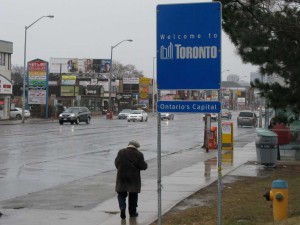
Most towns and cities have place signs at their borders. This is at Toronto’s northern boundary on Yonge Street.
Critical Toponymy, Colonisation and Commodification
Since the turn of this century toponymy has moved beyond etymological and taxonomic research to consider the politics involved in place naming. It has always been the case that a colonizing or imperial expansion has involved displacement of local names with new ones imposed by the conquerors. In the European expansions of the 18th and 19th century this was done partly to demonstrate authority and partly to honour those involved in the act of colonization by using names of the colonisers or the monarchs and aristocrats who supported them – Georgia, Victoria, Alberta, Sydney, Melbourne, Halifax, and so on in British colonies. Imported place names also provided a measure of familiarity for new settlers. Scarborough, which is now the eastern suburb of Toronto, was named by Elizabeth, the wife of the first Lieutenant Governor, John Graves Simcoe, because the cliffs along the lakefront reminded her of Scarborough in Yorkshire. What is now Toronto was named York at its founding in 1793, officially in honour of the Duke of York, son of George III (the same Grand Old Duke of York who marched his men to the top of the hill and marched them down again) but I suspect homesickness for a familiar bit of England had something to do with it.
The name was changed to Toronto in 1832 apparently because of confusion caused by having too many places called York, but York lingers on in the names of other municipalities and a university. Toronto is an indigenous place name that means something “trees standing in water” that described a weir on a lake about 90 kilometres north of the present day city. Eighteenth century fur traders used it to refer to the lake, and then to describe a portage to rivers flowing into Lake Ontario, and then for a trading fort near the current city. There was no First Nations settlement on the site of York when the British arrived, but Fort Toronto had been close by so it was the closest thing to a local place name that could be adopted.
The rewriting of place names is, as one toponymist has said, an uneven process. When it is done in the deliberate way of Simcoe it is often part of a process of claiming territory and making clear who the new owners are. But even when the naming is well-intentioned, the process can still be contested. Alderman and Inwood have written, for example, about how the renaming of streets Martin Luther King Way was often done without consulting local Black American communities, some of whom therefore felt further marginalized by a process that was intended to be inclusive. [Something similar is noted by Lucy Lippard who has recently written about place names in New Mexico. She writes that: “One way of reading places is to look at the history of their naming,” and “sites are constantly re-identified according changing regimes and local power structure,” a point she illustrates with examples of Indian and Spanish place names being converted to English, and in some cases back again.]
In some small ways place name injustices in North America and elsewhere are being undone as features and places once named for Europeans are winning back their indigenous names. What was previously called Mount McKinley in Alaska, named for a US President and the tallest mountain in North America, has in 2015 been renamed Denali, the locally used indigenous name. In an announcement about the change the US Secretary of the Interior declared: “With our own sense of reverence for this place, we are officially renaming the mountain Denali in recognition of the traditions of Alaska Natives and the strong support of the people of Alaska.”
Reuben Rose-Redwood suggests that an increasingly important concern for critical toponymists is the commercialization of place names. This is more than a matter of developers finding names for new projects that will be attractive to prospective investors and home-buyers. Corporate developers now often have streets in major projects named for themselves, and sports stadiums (Etihad Stadium for Manchester City, Rogers Centre in Toronto for the Blue Jays) named for the major sponsor, and when the sponsor changes the stadium name can change. The names of metro rail stations in Dubai were sold to corporate sponsors as a form of advertising for them and revenue generation for the transit authority. It seems that toponymic commodification and place branding are merging. My favourite example is the conflation of Montreal with Coca Cola that happened for the 350th anniversary of the founding of the city in 1992. I understand that this is the only time that Coca Cola’s distinctive calligraphy has been used for other purposes. I hope it is the only time a city allows itself to merge with a corporation and a commodity.
References:
– Derek Alderwood and Joshua Inwood, 2013, Street Naming and the Politics of Belonging: Spatial Injustices in the toponymic commemoration of Martin Luther King Jr, Social and Cultural Geography
– L. Deroy, et M Mulon, 1992 Dictionnaire de Noms de Lieux, (Paris: Les Usuels)
– S. Feld. and K.H. Basso (eds) 1996 Senses of Place (Santa Fe: School of American Research Press)
– Lucy Lippard 2015 “Place and Histories” in Jeff Malpas (ed) The Intelligence of Place, (London: Bloomsbury Press), pp 55-59.
– Richard Randall, 2001 Place Names: how they define the world – and more (Lanham, Md.: Scarecrow Press)
– Reuben Rose Redwood, 2011, Rethinking the Agenda of Political Toponymy, Acme
– Edward Relph 2014 Toronto: Transformations in a City and its Region, University of Pennsylvania Press) [where I discuss the erratic origins of the name of Toronto]
– S. Taylor (ed) 1998 The Uses of Place Names (Edinburgh: Scottish Cultural Press) [Corstorphine and Gwaun Henllan]
http://ojs.unbc.ca/index.php/acme/article/viewFile/884/740
